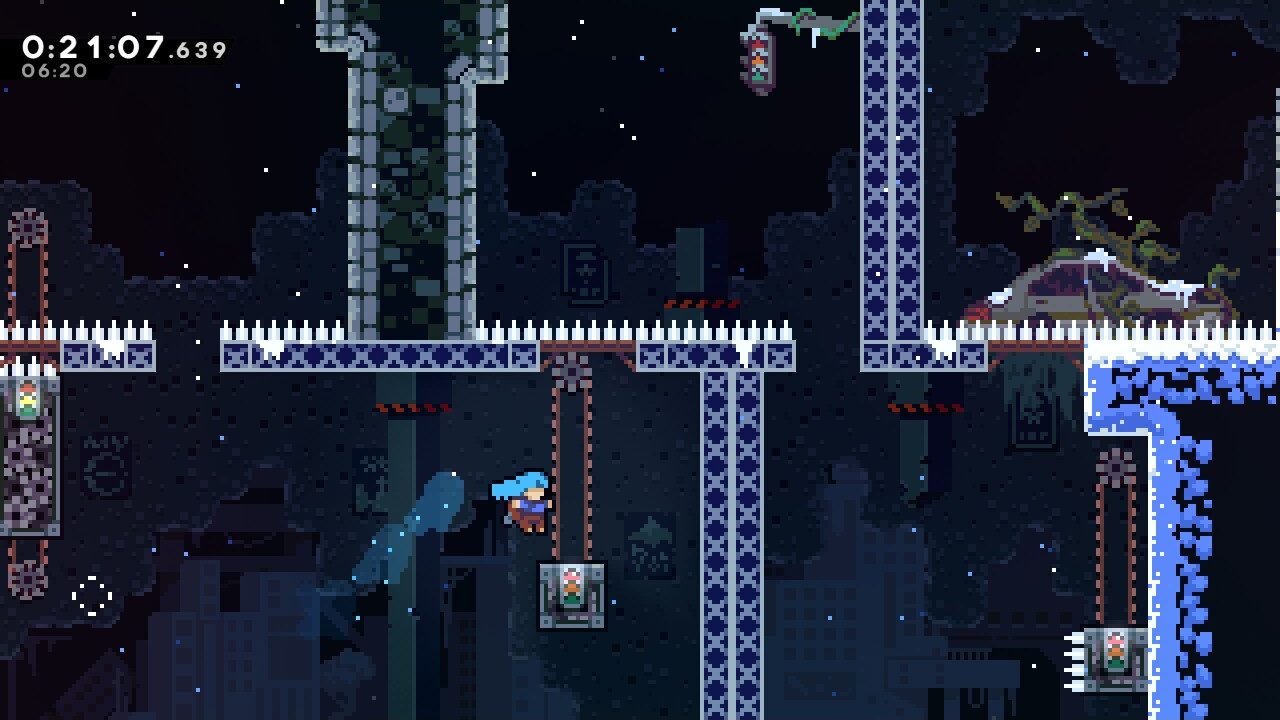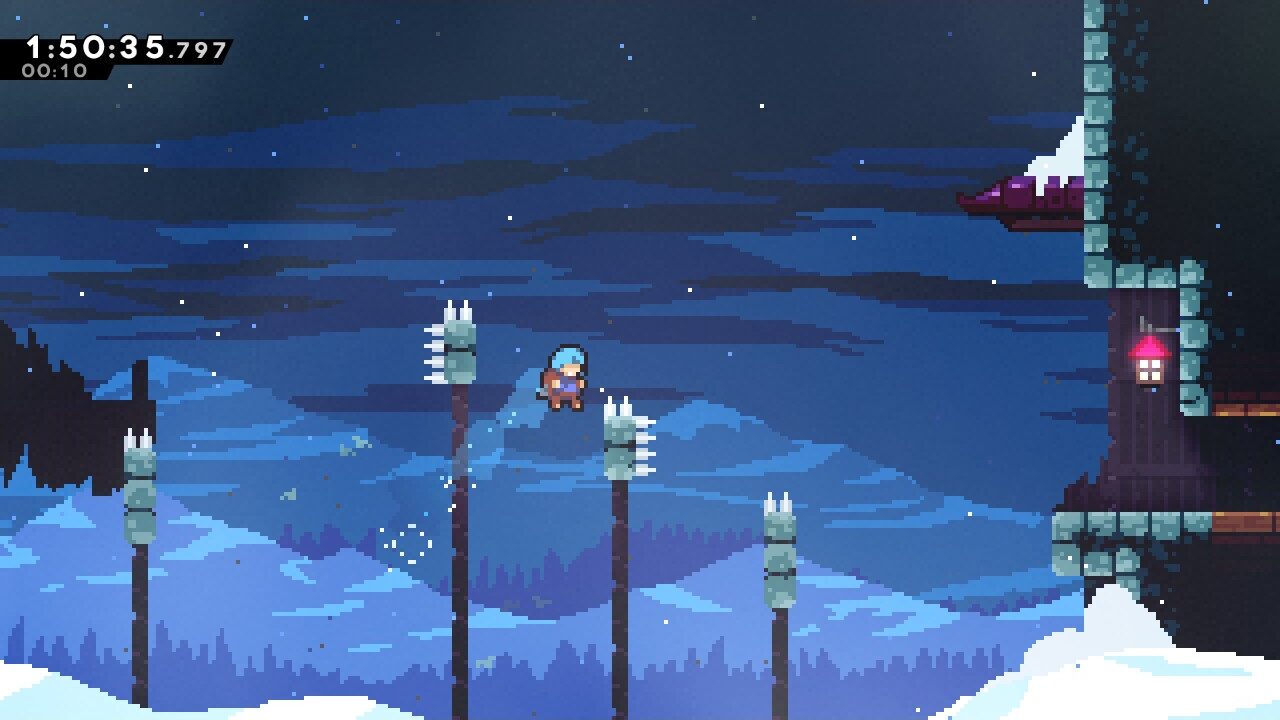Celeste: Throw yourself at a wall until you make a hole in it.
Video games are a great source of entertainment: they’re fun, they’re absolutely art, and they can bring isolated people together. In this returning series, Jayden Cammarata—Witherly Heights’ game critic—reviews a few that he liked… or didn’t.
By: Jayden Cammarata
Soundtrack sample- Resurrections
Celeste is the second game by Matt Makes Games studio (since rebranded as Extremely OK Games). It’s a brutally difficult platformer about climbing a mountain that excels because of its clean, tight gameplay and rich storytelling.

Celeste is a platformer game. This genre of games is distinguished by gameplay that consists of walking around on different platforms and jumping over or avoiding obstacles such as pits, spikes, and goombas.
To iterate on this gameplay, Celeste adds some mechanics that allow it to create more interesting and challenging levels. Most significantly, it gives players the ability to dash in the 8 cardinal directions, which gives the player more control over where they go in the air. However, the player can only dash once after leaving the ground, which means they must think about when to dash and when to save it– essentially, the dash works like a modified double jump.
The game also introduces other mechanics in the form of obstacles that show up in certain levels. For example, traffic light blocks are introduced in chapter one. After the player steps on one, it travels along a set path, and if the player jumps off of it, they’ll be flung off with all its momentum– potentially towards exactly where they need to go, and potentialy straight into a wall of spikes.

Celeste is a game about persistence and determination. It’s extremely difficult, but the game expects its players to fail– it treats death as a complete non-issue. Each death only sends the player back to the entrance to a screen, which means losing usually less than a minute of progress– even less in the early game. Therefore, with enough persistence, any player can practice a screen until they memorize and execute the exact sequence of moves required to finish it.
This is Celeste’s biggest flaw: its gameplay is built around doing the exact same thing and failing at it repeatedly, which can get extremely frustrating. However, it is also Celeste’s biggest strength: overcoming a challenge through pure skill is fun, the game forces its players to do that repeatedly.
This means that some people will enjoy the game much more than others. A player who’s willing to die in the same place dozens or hundreds of times will appreciate the game for the payoff of overcoming a challenge, and a player who’s somewhat patient may practice their determination, but an impatient player may just decide that they hate the game because it’s too hard for them.
Celeste, by its very nature, involves frustration, and this is not normally a pleasant experience; therefore, the game focuses on making sure that the payoff is worth the struggle. This is done two ways. First, the game makes its levels very hard, so beating them is very satisfying. Second, the game subtly helps you beat them, so that failing on them is slightly less frustrating.
One example of Celeste’s generosity is in its movement system. You can’t normally jump in midair, but if you try to jump right after you’ve walked off the edge of a platform, you’ll be able to jump in midair as if you had jumped slightly earlier. This mechanic (known as Coyote Time) helps make sure that when the player dies, it doesn’t feel like it was the game’s fault.
In general, the movement system in Celeste is incredible– moving around in the game just feels fun. Madeline accelerates slowly enough that movement feels natural and fluid, and that moving around requires a bit of forethought, but fast enough that she feels responsive to inputs; Madeline’s top speed is fast enough that going faster than normal feels appropriately fast, but slow enough that players can see where they’re going with enough time to react. It’s hard to describe why this balance is so important, but it is a big part of why the game is so fun.
Beating Celeste is hard enough to require getting extremely good at the game, and this is why it’s fun: overcoming a challenge is satisfying because it involves getting better at something. One element of Celeste that makes it even better is its potential for mastery, which goes far beyond what’s required for beating the game. For example, even a player who has beaten the game and all of its optional challenges might never have learned about the Demodash, which allows players to fit through small gaps between spikes and skip whole sections of the game, or about Chained Ultradashes, which allows players to keep building up speed indefinitely.
Celeste also has a lot of optional content for people to apply their mastery over the game to. The game has a hardmode and multiple bonus levels for players to attempt after beating the game, and Celeste fans have created high-quality but absurdly difficult mods for players to try after beating even that.

If it were just a game, for all of the reasons I’ve already mentioned, Celeste would be fantastic. However, it’s also an artistic masterpiece.
Celeste’s visuals are very good, although they don’t quite match those of some games like Hollow Knight. Its music is even better: I have never heard music close to as good as Celeste’s soundtrack.
There are a few reasons I like the game’s music. It’s very intricate and layered, so that memorizing and getting bored of it is difficult, and it stands up to repeated listening; that’s important, since it’s easy to get stuck on one place in a level for several hours. The songs also progress and build upon themselves throughout a level, developing along with the story; this keeps the songs fresh, and also creates an additional reward for conquering Celeste’s challenges.
However, the soundtrack’s greatest strength is how well it ties into the game’s story. The music is densely populated with leitmotifs that connect it to the story, and it’s great at creating an atmosphere that’s always perfectly suited to the situation it plays in, further connecting the story and the music to each other. One of Celeste’s greatest strengths is actually how closely everything is tied to the game’s story. For example, some players have theorized that the advertisements in the background art of the first level, the Forsaken City, are symbolic of the insecurities that drove Madeline to Celeste Mountain. This isn’t just limited to the graphics and sound design of the game: even the game’s gameplay and level design are connected to its story. For example, obstacles which give you more control over Madeline, like traffic light blocks and bubbles, appear when Madeline is at her highest points, and elements which take that control away, like seekers (the eldritch abominations in chapter 5) and red bubbles, appear when she’s mentally struggling the most.
These details will make the game even more fun for people who can appreciate its challenge. However, it won’t help much for people who can’t stand the frustration it involves. The game does include an Assist Mode which lets those people skip the challenge and experience Celeste’s story and environment without working for it, but this takes a lot away from the game– it essentially becomes a short film, not a game at all.

Celeste is one of my favorite games of all time. It revolves entirely around trying and failing repeatedly at brutally hard challenges in order to master the game, and this brings with it a major downside– the risk of frustration– and this can make the game inaccessible for many players. Fortunately, it handles this issue expertly. Because of its tough but satisfying gameplay and the masterful story, I think the best way to describe Celeste is as a masterpiece.
Overall rating:
6/10 or 10/10 depending on your patience
This Game ASAP:
Catcher in the Rye if J. D. Salinger liked hard video games.
The Deicide Boolean: No.
Tips:
- If you’re playing on a controller, it’s easy to dash in a direction you didn’t mean to– for example, right instead of diagonally up and right– and die even though you meant to make the right move to survive; this is the one exception to the rule that when you die in Celeste, it’s your own fault, and it’s extremely frustrating even compared to normal gameplay. Learn to play the game on a keyboard, not a controller.
- Try out some of the advanced movement techniques Celeste players have found. None of them are required until extremely late in the game, but they might help you beat earlier levels anyway, and having practiced wallbounces or wavedashes by the time they’re required could be very helpful. There are plenty of tutorials online to show you how to do these things; here’s one from the game itself.
- Buy Celeste on the computer so that you can download mods for it. Many mods for the game are far more polished and high-quality than some standalone games– for example, the 2023 Strawberry Jam Collab is a free download that I think is worth at least $20.
(Fanart by Alexandre Morellon)
